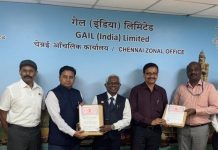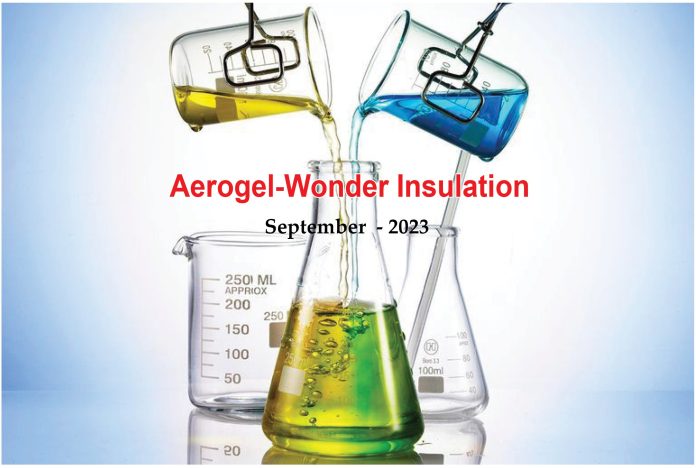Aerogel insulation is a game-changer for industry. Its low thermal conductivity and hydrophobic properties make it a formidable defence against temperature extremes and corrosion under insulation (CUI). With applications in refineries, petrochemical facilities, and LNG plants, aerogel insulation maintains process efficiency, reduces energy costs, and extends asset lifespan, all while withstanding harsh environmental conditions.
Aerogel – Wonder Insulation
Aerogel has the structural properties of a solid but is 97% air. It is the lightest solid to be ever created. It is also the most insulating material known to us.
Prologue
There is a significant scope for energy savings and reduced greenhouse gas emissions by improving the thermal insulation in the chemical industry. A normal chemical plant has 6-10% of its asset value in insulation systems. Energy audits are revealing that the industry continues to use outdated technical specifications resulting in insulation systems that are neither energy-efficient nor cost-effective under present market conditions. Maintenance of insulation is also grossly neglected. The pressure to reduce investment and maintenance costs, an increasing lack of insulation know-how and split responsibility for energy and maintenance budgets are among the main factors responsible for this situation.
Conventional Materials
Traditionally, materials like calcium silicate, mineral wool and fibreglass have been the mainstays of thermal insulation in the chemical industry. But they come with certain inherent limitations. One of the major drawbacks of these materials is the natural aging and degradation when subjected to humidity and thermal fluctuations, thereby reducing the thermal performance over their lifespan. They are bulky and heavy and add to the footprint and weight of equipment and piping. They also present challenges during installation, which can be time-consuming and labour-intensive. A growing crop of novel materials with unique properties have emerged in recent times and are on the threshold of revolutionising insulation management. The most promising among them is aerogel.
Aerogel
Aerogel owes its creation to a wager between Samuel Kistler and his fellow scientist Charles Learned over whether it was possible to replace the liquid inside a jelly jar without causing shrinkage. Kistler transformed the liquid into a supercritical state by increasing the temperature and pressure and then lowered the pressure, which vaporised and drove away the liquid leaving just the solid intact. Aerogels were commercialised as early as the 1940s by Monsanto, which made an aerogel-based product for use as a thickening agent in paints. However, in the 1970s the plant was closed down due to high manufacturing costs and stiff competition from other products.
NASA Spinoff
The credit for reviving aerogels goes to NASA. Aerogels were brittle to the point of uselessness, as well as costly to make and in the 1990s NASA put out a call for a flexible composite aerogel that could be used to manage the transfer and handling of cryogenic rocket fuels. The challenge was taken up by a company called Aspen Systems, which proposed a silica aerogel reinforced with ceramic fibres. The innovative product turned out to be less than half as conductive as even the best foam insulations of those days. They soon became the first, practical aerogel insulation and were used in many critical applications including Mars Rover.
The extremely low thermal conductivity (0.013 W/m K) makes aerogels attractive thermal super-insulators mainly by minimising heat conduction through their low density (80–200 kg/m3) and tortuous solid nanostructure (mesopore diameters between 4 and 20 nm). However, this comes at the expense of physical and mechanical properties. The low compressive strength and high susceptibility to fracture make them difficult to handle, and the damage can negatively affect the thermal performance. Additionally, aerogels are also prone to settling over time, especially when exposed to vibration or thermal cycling. To improve the durability and structural characteristics of aerogels for heat insulation applications, fibre-reinforced aerogel blankets (FRABs) have been developed. Typically, a FRAB is composed of aerogel particles covering a network of reinforcing fibres (polymer or ceramic) acting as a supporting skeleton.
CUI
Industrial insulation often faces challenges from water, especially in environments prone to heavy rainfall, high humidity, and exposure to ocean air, common in refining and petrochemical facilities. Aerogels are uniformly distributed in the blanket, creating an inherently hydrophobic composite that resists water ingress, even on cut edges. This hydrophobic property sets aerogels apart from surface-coated insulations.
Cryogenic Applications
Conventional LNG storage systems employ double-walled tanks with a deep-vacuum space filled with insulation material. Bulk-fill and layered systems are the primary solutions for tank insulation. Multi-layer insulation (MLI) offers the best thermal performance, achieving thermal conductivity values below 0.03 W/m K. However, MLI effectiveness depends on maintaining a vacuum level below 10−3 Pa, which can be challenging and costly to maintain. Bulk-fill systems, often using expanded perlite, offer a good balance of thermal performance, cost-effectiveness, safety, and low maintenance. However, perlite tends to compact and settle over time, increasing heat loss and causing potential damage to internal components. Water adsorption in perlite is another issue, leading to increased evaporation rates and maintenance costs.
Implementing FRAB technology in LNG cryogenic tanks could result in storing more LNG in the same tank volume, significantly reducing tank weight, lowering transportation costs and fuel consumption, and ensuring effective thermal insulation without the need for a vacuum, enhancing safety, cost-efficiency, and design simplicity.
Challenges
The manufacturing of aerogels involves a sol-gel process, with subsequent solvent removal without damaging the material’s porous structure. Supercritical drying, initially problematic due to solvent removal challenges, saw improvements with the Hunt process using CO2. Improvements continue to be made to optimise the supercritical process and reduce the associated costs, this includes work on a continuous process and recycled feedstocks. Development also continues for alternative processes, this includes ambient pressure drying, freeze-drying, and even 3D printing.
Material costs significantly impact aerogel production, prompting efforts to employ cheaper or eco-friendly materials. Despite certain outstanding properties of silica aerogels, brittleness is a key limitation. This means that nearly all the commercial products to date include the aerogel as part of a composite design, with the other components either introduced during gelation or post-processing to provide structural integrity. In addition, surface treatments and other post-processing procedures have been developed to allow the porous structure to persist in a variety of environmental conditions.
Epilogue
The aerogel industry has faced setbacks in market penetration due to competition from more affordable materials. However, capacity expansion, increased awareness, alignment with market demands, and ongoing technical innovations are driving its growth and diversification.
































